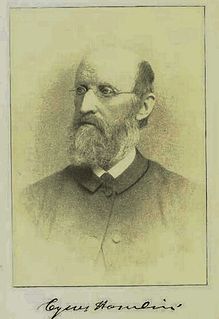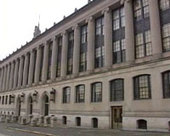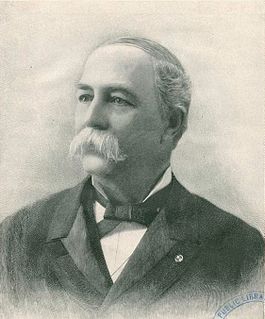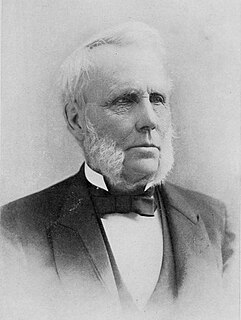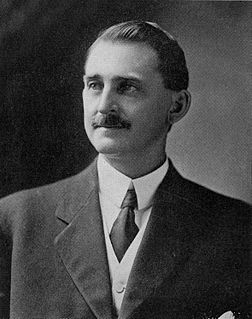George W. Higgins was an American minister of the Holy Ghost and Us Society. He was probably the last person in New England to be subjected to the traditional mob-led humiliations of tarring and feathering and riding the rail. The incident occurred in Levant, Maine, just outside Bangor in 1899, and resulted in the trial of 29 members of a mob numbering about 150 persons.

The United States of America (USA), commonly known as the United States or America, is a country composed of 50 states, a federal district, five major self-governing territories, and various possessions. At 3.8 million square miles, the United States is the world's third or fourth largest country by total area and is slightly smaller than the entire continent of Europe's 3.9 million square miles. With a population of over 327 million people, the U.S. is the third most populous country. The capital is Washington, D.C., and the largest city by population is New York City. Forty-eight states and the capital's federal district are contiguous in North America between Canada and Mexico. The State of Alaska is in the northwest corner of North America, bordered by Canada to the east and across the Bering Strait from Russia to the west. The State of Hawaii is an archipelago in the mid-Pacific Ocean. The U.S. territories are scattered about the Pacific Ocean and the Caribbean Sea, stretching across nine official time zones. The extremely diverse geography, climate, and wildlife of the United States make it one of the world's 17 megadiverse countries.

New England is a geographical region composed of six states of the northeastern United States: Maine, Vermont, New Hampshire, Massachusetts, Rhode Island, and Connecticut. It is bordered by the state of New York to the west and by the Canadian provinces of New Brunswick and Quebec to the northeast and north, respectively. The Atlantic Ocean is to the east and southeast, and Long Island Sound is to the south. Boston is New England's largest city as well as the capital of Massachusetts. The largest metropolitan area is Greater Boston with nearly a third of the entire region's population, which also includes Worcester, Massachusetts, Manchester, New Hampshire, and Providence, Rhode Island.

Tarring and feathering is a form of public torture and humiliation used to enforce unofficial justice or revenge. It was used in feudal Europe and its colonies in the early modern period, as well as the early American frontier, mostly as a type of mob vengeance.
Higgins was from Calais, Maine. The Holy Ghost and Us Society was a millenarian religious sect founded by Frank Sandford, and headquartered at Shiloh Temple in Durham, Maine. Sandford encouraged his followers to donate all their property to the church and live communally at Shiloh. As a missionary for the Society, Higgins had made about 15 converts in the town of Levant, including some prosperous farmers who had been induced to give up their property to the church. Known locally as 'Higginsites', the sect was blamed by townspeople for the suicide of an elderly blind woman who was one of its members, and for administering a beating to a child whom Higgins had claimed was possessed by a demon.

Calais is a city in Washington County, Maine, United States. As of the 2010 census, it had a population of 3,123, making Calais the third least-populous city in Maine. The city has three Canada–US border crossings over the St. Croix River connecting to St. Stephen, New Brunswick, Canada.
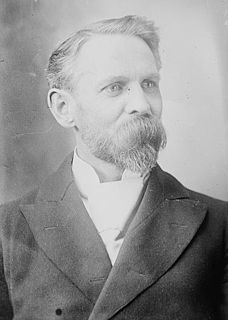
Frank Weston Sandford was an American religious leader, preacher, and religious extremist, who attained notoriety during the Pentecostal Era as the founder and leader of "The Kingdom".

The Shiloh Temple, now Shiloh Chapel, is a historic religious facility at 38 Beulah Lane in Durham, Maine. Built in 1897, the surviving building is a small portion of a once-extensive religious enclave established by the evangelical Christian cult leader Frank Sandford, exhibiting a unique expression of religious and summer retreat architecture. The building was listed on the National Register of Historic Places in 1975.
Two of Levant's selectmen asked Higgins to leave town, which he refused to do. A mob of about 150, some of whom were masked, dragged Higgins from the house of disciple Ruel Clement one night in 1899, stripped him naked, covered him with hot tar, and applied a coat of chicken feathers. He was then ridden to the edge of town on a wooden rail, and left there with the warning not to return. He did return to Clement's house, however, and Clement's complaint to the Sheriff of Penobscot County led to the arrest and trial in Bangor of 29 people, many of them 'solid citizens' of Levant. [1]

Bangor is a city in the U.S. state of Maine, and the county seat of Penobscot County. The city proper has a population of 33,039, making it the state's 3rd largest settlement behind Portland (66,882) and Lewiston (36,221).
In 1901 Ruel Clement contracted typhoid and died without taking medicine or seeing a doctor, believing his faith would cure him. Higgins returned to Levant to conduct the funeral. [2]
U.S. Senator Frederick Hale of Maine recounted that when he challenged the Ambassador of China over the bad treatment received by some American missionaries in that country, in 1899, Ambassador Wu brought up the "Levantine Affair" (Higgin's tarring and feathering) as a counter-example of domestic religious intolerance, leaving Hale speechless. [3]



